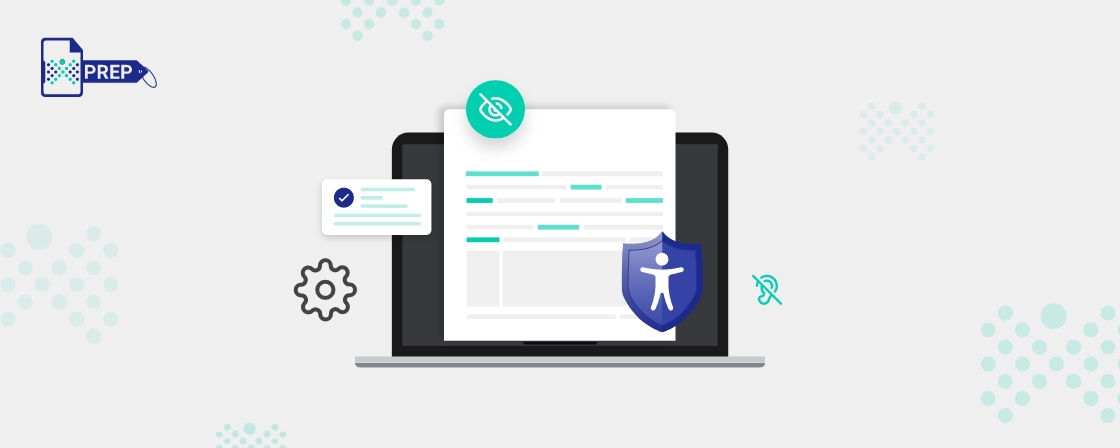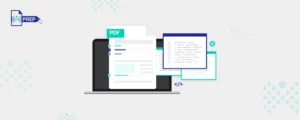What is ADA Compliance?
The Americans with Disabilities Act (ADA) is a civil rights legislation that prohibits discrimination against people with disabilities. It also guarantees them the same opportunities as everyone to participate in mainstream American life. ADA accessibility guidelines ensure accessibility to all individuals, regardless of their physical limitations.
What is ADA Compliance?
Presently, ADA guidelines expand beyond handrails, wheelchair accessibility, or parking spaces. With technological advances, ADA compliance standards now encompass all public-facing entities, including most websites, communications, software, and accessibility checkers. People can often get confused between ADA and Section 508. Therefore, it’s important to learn that Section 508 ensures accessibility for digitally published material within government agencies and entities, whereas the ADA compliance requirements apply broadly to society, commerce, and government.
Importance of ADA Compliance
- Promoting Equality :When your website meets ADA standards, it shows that your business is fair to everyone. This demonstrates that you value accessibility, which can improve your company’s reputation.
- Legal Compliance:Ensuring your website meets ADA standards is crucial for avoiding expensive legal troubles. Ignoring accessibility can lead to:
- Paying legal fees.
- Settling lawsuits.
- The expense of redesigning your website to comply with ADA regulations.
- Facing negative publicity that could hurt your profits.
- Enhances Website Experience :Websites that prioritize accessibility are easier for everyone to use, not just people with disabilities. For instance, adding captions to videos can help people understand content in noisy environments.
- Boosts Business Growth :Businesses that care about social responsibility often get support from people who value the inclusion of individuals with disabilities. These businesses provide equal job opportunities and adhere to ADA standards for accessibility. Being socially responsible not only meets ADA compliance but also attracts more customers, expanding the potential customer base.
- Tax Credits: The IRS (Internal Revenue Service) gives businesses some special benefits called tax credits if they make their workplaces more accessible for people with disabilities. One of these benefits is the disabled access credit, which can give businesses up to $5000 for making improvements for people with disabilities. It’s not just about following the rules (called ADA compliance); it also makes good financial sense. If a business hires someone with a disability, they can get up to $6000 in credits for that person’s first year of work. And if businesses hire more people with disabilities, there’s a special tax credit called the work opportunity credit for them too.
Who is Impacted by ADA Compliance Standards?
Now that you understand what ADA compliance is, you might be wondering who it affects.
ADA rules apply to:
- State and local government agencies
- Businesses that serve the public
- Stores
- Banks
- Hotels
- Hospitals
- Doctor’s offices
- Restaurants
- Movie theatres
Because ADA rules also cover technology, like the Internet and websites, almost all businesses and website owners need to follow them. Usually, websites aren’t ignoring ADA rules on purpose.
Even if ADA rules don’t directly affect you, making a website that everyone can use is still really important.
What are the ADA Compliance Standards?
All types and sizes of businesses must comply with ADA legislation to ensure accessibility for their customers and employees (if there are over 15 employees). ADA compliance standards apply to local government offices, state government offices, non-profits, and businesses. To simplify the requirements, ADA is divided into five sections:
- Title I – Employment
- Title II – Public Services (state and local government)
- Title III – Public Accommodations and Services Operated by Private Entities
- Title IV – Telecommunications
- Title V – Miscellaneous Provisions
Is ADA Compliance Mandatory?
Who Made the Document:
- Government Bodies: Documents made by federal, state, and local governments must follow ADA rules outlined in Section 508 of the Rehabilitation Act of 1973. This includes PDFs, Word files, and other formats, for both public and internal use.
- Private Organizations: The original ADA law doesn’t directly say private businesses must make their documents ADA-friendly. But it’s still a good idea to do so.
Who Will Use the Document:
- Public Documents: Things like brochures, manuals, and website content meant for everyone should be accessible, no matter who made them.
- Internal Documents: While it’s not legally required, making internal documents ADA-compliant can help employees with disabilities and make things easier for everyone.
It’s a must for all websites to follow ADA rules by federal law. If your site doesn’t meet these rules, you could face serious consequences, like being fined over $100,000 for each violation. Your website might get into legal trouble with the government or private citizens.
Some big names, like Target, Amazon, and even Beyonce, have faced lawsuits for not following ADA standards. Ignoring these rules not only means missing out on potential customers but also opens the door to legal issues. Apart from lawsuits, not having an ADA-compliant website can lead to penalties, settlement fees, bad public relations, and the cost of redesigning your site based on complaints.
Role of Web Content Accessibility Guidelines (WCAG) in ADA Compliance:
WCAG, which stands for Web Content Accessibility Guidelines , is a set of rules created back in 1999 to help make websites more accessible. In 2018, a newer version called WCAG 2.1 came out, focusing on making the web easier to use for people with disabilities.
These guidelines are like a checklist for web designers and content creators to follow. While you don’t have to stress about WCAG compliance, using them can help you make your website compliant with the ADA, or Americans with Disabilities Act. So, WCAG acts as a guide for making sure your website is accessible to everyone.
Core Principles for a WCAG-Compliant Website:
Perceivable:
You want users to easily see and understand everything on your website, like text, pictures, videos, and other content. Even if someone can’t see the text or watch the videos, you need to give them another way to access the information.
Operable:
You want users to be able to move around your site and use all its parts. Everyone should be able to use the main menu and any tools your site offers, like calculators.
Understandable:
You want your website content to be easy for users to understand. This means they should get what your text, images, videos, and tools are all about. For instance, if your site has instructions for using something like a calculator or a contact form, users should be able to follow along easily.
Consistent:
You want all users to have a similar experience, whether they’re using assistive technologies or not. For example, whether someone is reading your content or using a voice reader, they should get the same information even if it’s presented differently.
How to Check Your Website for ADA Compliance?
You can make sure your website follows ADA rules in a few ways:
- Use a web accessibility tool like WAVE.
- Install a web accessibility plugin, especially for WordPress sites.
- Get a professional audit done.
- Do a manual check yourself.
What Happens if Your Website isn’t ADA-compliant?
If your website doesn’t follow ADA rules, it might not be on purpose, but that doesn’t matter much. Not meeting these rules can lead to expensive lawsuits, even if you didn’t mean to break any rules from the U.S. Department of Justice.
Besides the legal trouble, it also means you might lose customers who have disabilities because they can’t easily use your site. To avoid these issues, it’s important to pay attention to ADA compliance rules and make your website accessible for everyone, ensuring you don’t miss out on potential customers for your business.
ADA Non-Compliance Penalties:
Fines:
If organizations or businesses break ADA rules, they may get fined up to $75,000 for one violation, and it doubles to $150,000 for more violations. This can be a huge expense for most businesses and cause serious problems.
Lawsuits:
People can sue if they’ve faced discrimination that goes against Title III of the ADA. The best way to steer clear of the bad consequences of not following ADA rules is to make sure your site follows the rules and stays compliant.
FAQs
- What does ADA compliance require?
- Having buildings without barriers for people with disabilities
- Making sure communication is accessible, like using aids or services
- Giving fair treatment and accommodations to employees with disabilities
- Hiring and promoting people with disabilities
- Making sure employees with disabilities get the same training and benefits
- Is ADA the same as WCAG?
- What are some examples of ADA Compliance?
- Having parking spots for people with disabilities
- Putting in ramps for wheelchairs
- Using Braille signs
- Making websites and online stuff that meet WCAG 2.0 AA Guidelines
- How much does reaching ADA compliance cost?
ADA compliance means making sure everyone, including people with disabilities, can access everything fairly. This includes:
ADA and WCAG are different. WCAG is a set of rules from the World Wide Web Consortium (W3C) for website accessibility. The U.S. Justice Department suggests using WCAG to follow ADA rules, and most businesses do.

